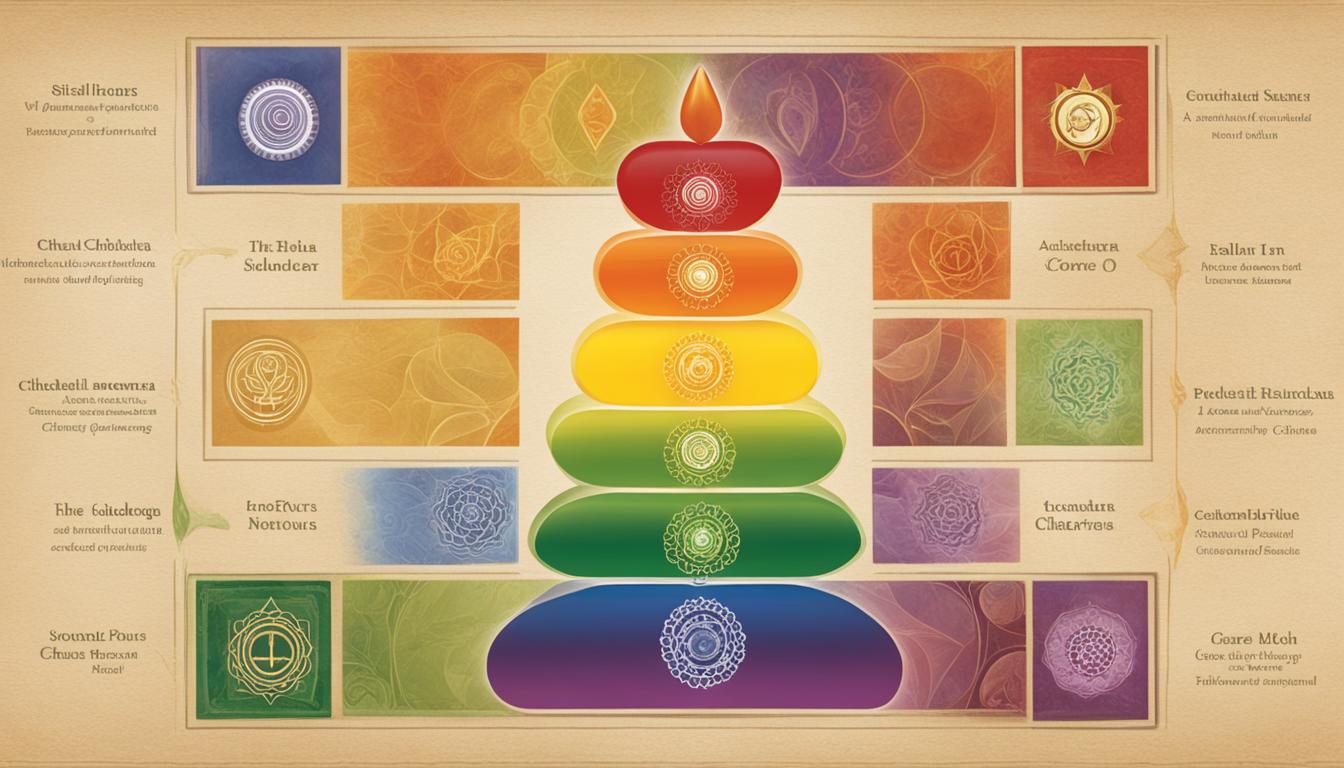Welcome to our exploration of the fascinating world of chakras! Originating in ancient India and documented in sacred texts, chakras are energy centers that play a crucial role in our physical, emotional, and spiritual well-being. By studying the chakra system, we gain valuable insights into the profound impact it can have on our lives.
There are seven main chakras that run along the spine, each associated with a specific area of the body, color, and health focus. These energy points are believed to influence different aspects of our being, such as our emotions, physical health, and spiritual connection.
So, why do we study the chakras? Understanding the chakras allows us to identify any imbalances or blockages that may be disrupting the flow of energy in our bodies. By recognizing these imbalances, we can take proactive steps to restore harmony and promote overall well-being.
Key Takeaways:
- The chakras are ancient energy centers that have a significant impact on our well-being.
- Studying the chakra system helps us recognize imbalances and restore energy flow.
- Each chakra is associated with specific areas of the body, colors, and health focuses.
- Understanding the chakras can lead to improved physical, emotional, and spiritual health.
- Exploring the chakras allows us to cultivate self-awareness and spiritual connections.
The Seven Main Chakras and Their Functions
Studying the chakras can offer a multitude of reasons for those seeking to enhance their overall well-being. The seven main chakras, namely the root, sacral, solar plexus, heart, throat, third-eye, and crown chakras, play a vital role in our physical, mental, and emotional health. Understanding the functions of each chakra and the energy it encompasses can unlock numerous benefits and personal growth opportunities.
Root Chakra: Located at the base of the spine, the root chakra is associated with the adrenal glands and is responsible for our sense of security, stability, and groundedness.
Sacral Chakra: Situated in the lower abdomen, the sacral chakra is linked to the reproductive organs and governs our creativity, passion, and ability to experience pleasure.
Solar Plexus Chakra: Positioned above the navel, the solar plexus chakra is connected to the pancreas and influences our confidence, personal power, and sense of self-worth.
Heart Chakra: Located in the center of the chest, the heart chakra is associated with the thymus gland and governs our ability to love, show compassion, and form meaningful connections with others.
Throat Chakra: Situated in the throat region, the throat chakra is linked to the thyroid gland and influences our communication, self-expression, and ability to speak our truth.
Third-Eye Chakra: Positioned in the middle of the forehead, the third-eye chakra is connected to the pituitary gland and is responsible for our intuition, insight, and spiritual awareness.
Crown Chakra: Located at the top of the head, the crown chakra is associated with the pineal gland and represents our connection to the divine, higher consciousness, and spiritual enlightenment.
By delving into the study of chakras, individuals can gain a deeper understanding of their unique energy centers and how they impact different aspects of their lives. Such knowledge empowers individuals to identify and address any imbalances or blockages, leading to enhanced overall well-being on a physical, mental, and emotional level.
Exploring the Benefits of Chakra Study
Studying the chakras offers a multitude of advantages. By delving into the intricate system, we gain a deeper understanding of our energy centers and how they impact our overall well-being. Through this knowledge, we can identify any imbalances or blockages that may exist within our chakras and take proactive steps to restore harmony and flow within our energy system.
One of the primary purposes of studying the chakra system is to promote improved physical health and emotional stability. Each chakra is associated with specific organs, glands, and aspects of our physical and emotional health. By addressing any imbalances or disruptions in the chakras, we can alleviate physical ailments, enhance emotional resilience, and experience an overall boost in well-being.
Furthermore, engaging in chakra study allows us to cultivate a deeper sense of self-awareness and spirituality. Through practices such as yoga, meditation, and chakra cleansing, we can connect with our inner selves on a profound level. This connection strengthens our intuition, expands our consciousness, and brings us closer to our true essence. Ultimately, it paves the way for personal growth, self-discovery, and a more aligned and fulfilling life.
FAQ
Why should we study the chakras?
Studying the chakras allows us to understand and improve various aspects of our physical, mental, and emotional well-being. It helps us identify imbalances or blockages in our energy system and restore harmony and flow. Additionally, studying the chakras can deepen self-awareness and cultivate a greater connection to spirituality.
What are the seven main chakras and their functions?
The seven main chakras are the root chakra, sacral chakra, solar plexus chakra, heart chakra, throat chakra, third-eye chakra, and crown chakra. Each chakra is associated with a specific area of the body, color, endocrine gland, and health focus. For example, the root chakra is associated with the adrenal glands and relates to our sense of security and stability, while the heart chakra is linked to the thymus gland and governs our ability to love and connect with others.
What are the benefits of studying the chakras?
Studying the chakras offers numerous benefits. By understanding the chakras, we can identify imbalances or blockages and work towards restoring harmony and flow. This can lead to improved physical health, emotional stability, and overall well-being. Chakra study also allows us to deepen self-awareness and cultivate a greater connection to our spirituality. Practices like yoga, meditation, and chakra cleansing help balance and activate the chakras, leading to a more aligned and fulfilling life.





